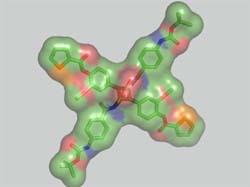
An orally available "small molecules" recently identified by CAS scientists may hold the key to a more convenient treatment of the most common type of human diabetes, released the website of the Proceedings of the National Academy of Sciences (PNAS) at the beginning of 2007. http://www.pnas.org/cgi/content/abstract/0610173104v1
According to the report, researchers made key discoveries when studying the agonists of glucagon-like peptide-1 receptor (GLP-1R), which is a widely acknowledged important drug target for metabolic disorders such as diabetes and obesity. By mimicking the effects of glucagon-like peptide-1 (GLP-1), an essential incretin hormone which augments insulin secretion in response to food intake, GLP-1R helps to maintain glucose homeostasis within the human body.
Diabetes is a chronic disease that occurs with deficiencies either on insulin production (type 1 diabetes) or in its effectiveness (type 2 diabetes). As one of the most common human diseases in modern society, it can cause hyperglycaemia and damages to the heart, blood vessels, eyes, kidneys and nerves over time. Type 2 diabetes comprises 90% of people suffering from diabetes around the world, and is largely the result of excess body weight and physical inactivity. The World Health Organization estimates that more than 180 million people worldwide have diabetes, and the number is likely to be doubled by the year 2030.
Despite the numerous efforts in combating diabetes, no convincing solutions have been developed for the 180 million diabetes sufferers. Studies on orally-available and small-molecular GLP-1R agonists were largely unsuccessful, and a drug Byetta (exenatide) recently approved by the U.S. Food and Drug Administration is deficient for short-acting and requires two daily injections.
WANG Ming-Wei, the lead author of the present study and director of China's National Center for Drug Screening under CAS Shanghai Institute of Materia Medica (SIMM), screened with his colleagues more than 48,000 chemical compounds to finally identify a small molecule called Boc5 with properties similar to GLP-1. Experiments on type 2 diabetic mice showed that Boc5, injected or orally taken, was effective to raise insulin sensitivity, reduce cholesterol levels and curb appetite. Within a month the subjects performed the same as the normal mice in serum glucose levels in addition to losing a considerable percentage of body weight.
Although Boc5 has only been tested in mice, it could be turned into pills once shown effective in humans, freeing the patients from the trouble of injection.
The paper, independently reviewed by Prof. Roger Unger and Prof. Stephen Bloom, both are prominent experts in metabolic diseases, will later appear as the This Week in PNAS article in the printed version of PNAS. Prof. Unger views highly of this "remarkable" discovery. "It is possible that this approach may not only revolutionize the treatment of type 2 diabetes, but in addition may herald an era in which other small non-peptidic molecules can be administered orally to mimic actions of peptide hormones," he commented.
Serious attention also came from the industrial circle home and abroad, for over 10 multinational pharmaceutical companies have expressed their interests in collaboration in this drug lead. Prof. Mads K. Thomsen, executive vice president/chief scientific officer with Novo Nordisk A/S and one of the forerunner of GLP-1 researches, said that his group was "truly impressed" that the CAS scientists "have been able to identify such an interesting molecule in a difficult area." Dr. Johan Selmer remarked that the "high standard data" were admirable even in the eyes of the "usually very critical" GLP-1 expert Novo Nordisk. Merck & Co., the first producer of sitagliptin (januvia) in the world, sent their congratulations through Dr. Lauren Shearman's letter, emphasizing the great challenges of the research and the highly innovative spirit of the Chinese researchers. The study was "most exciting and the biology package is impressive" according to Prof. Simon Campbell, a well-known chemist and fellow of the Royal Society in London.
Dr. Wang got his doctorate degree in physiology from the University of Cambridge in 1989, and joined SIMM in 2001. In 2003 he was appointed director of the National Center for Drug Screening under the SIMM. Co-sponsored by the Ministry of Science and Technology, CAS, the National Natural Science Foundation of China and Shanghai Municipality government, his research has already reaped a rich harvest with 7 national patent applications, including 2 international ones. If successfully commercialized, it will certainly result in tremendous economic and social benefits worldwide.
